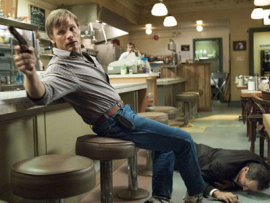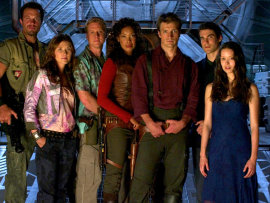 A HISTORY OF VIOLENCE
A HISTORY OF VIOLENCE
I was completely rapt by the austerity and dread of David Cronenberg's A History of Violence - for the first five minutes. In the film's beautifully sustained opening sequence, we watch as two men - one middle-aged, in a black suit, and another, younger and sporting a T-shirt and jeans - exit their motel room. They load up their car, and the older gentleman drops off the room key while the other - slowly, slowly - pulls the car up to meet him. Moments later, the older man returns, having had, he says, "a little trouble with the maid." But before they leave, they need water. The younger man enters the motel office to replenish their supply, and as he does, we finally see the image that Cronenberg has thus far denied us, and that we in the audience have properly anticipated - the motel manager and maid lying dead in pools of blood. A frightened little girl, gently stroking the hair of her doll, enters the scene and makes eye contact with the younger killer. And the man, smiling gently, tells her not to be afraid, slowly aims his revolver at the girl's head, and fires.
It's a horrifying, hypnotic prelude, not because of the violence - we don't actually witness any of these three murders - but because of its terrifying inevitability. All throughout the film, in fact, Cronenberg lulls us into a state of eerie calm that turns almost shockingly vicious. The brutality of the opening scene reverberates within every subsequent scene; violence, the director could be saying, begets violence, and we'd be fools to think otherwise. Much of Cronenberg's work here is extraordinary. Yet, sadly, the movie still feels like a crock.
A History of Violence concerns Tom Stall (Viggo Mortensen) of Millbrook, Indiana, a genial diner owner with an adoring wife, Edie (Maria Bello), two sweet kids, and the love of his small-town community. After foiling a robbery and killing the perpetrators in self-defense, Tom becomes an unwitting media celebrity, and, unfortunately for his family, attracts the attention of a trio of thugs from Philadelphia. What follows next shouldn't be revealed - the film features several surprising narrative twists - but is it xenophobic to suggest that part of the movie's weakness is the fault of Canada?
We're invited to accept the film's locale as Anytown, U.S.A., but the movie doesn't suggest any town in the U.S.A.; the populus' Canadian dialects are unmistakable, and distracting. Why didn't Cronenberg, a Canadian, simply transplant the material (it's based on a graphic novel by John Wagner and Vince Locke) to his native country? My guess is because A History of Violence is designed to be more than an action thriller; it's meant to be a critique on an entire culture, a distinctly American culture, rooted in violence. Yet like Danish director Lars von Trier's Dancer in the Dark and Dogville, which were also filmed outside the U.S., Cronenberg's work - the title is deliberately grand - examines American hostility and cruelty without seeming the least bit American. A History of Violence is less a movie than a 95-minute conceit; it feels like a grad-school thesis paper wherein the facts are accurate but the presentation is unconvincing.
But locale isn't the movie's biggest problem. The perfunctory, unimaginative dialogue is. Though Josh Olson's script is a model of economy and efficiency, its graphic-novel roots are unmistakable, and don't mesh with the grace and precision of Cronenberg's compositions. Small-town homilies like "We look after our own here" and "This is a nice town, with nice people" are bandied about, but the intentionally banal dialogue isn't stylized enough to be entertainingly banal, and when a character stammers, "What are you? Some kind of multiple-personality schizoid?", you don't know what kind of world you're in. (A line like that only works in a comic book, or in a film with a comic-book mentality.) Cronenberg's visuals are fiercely believable - no director showcases viscera quite like him - yet I never quite believed it when his characters spoke; the director's sureness of tone is constantly at odds with the script's lack of one.
Cronenberg's movie is frustrating because I can't recommend it despite there being so many commendable things in it. Mortensen comes through with a marvelously suggestive performance - most of the movie's drama, and much of its comedy, centers around what, exactly, might be going on in Tom's head at any particular moment - and Bello, Ed Harris, and William Hurt give their roles a wealth of detail that's nowhere to be found in the material itself. (Hurt, in a vibrant, hammy cameo, does his most entertaining work since 1987's Broadcast News.) And for Cronenberg completists, the movie should be unmissable - his directorial mastery is never in doubt. Yet A History of Violence never quite satisfies; it's Art Pulp, which, unfortunately, isn't quite the same thing as Pulp Art.
 OLIVER TWIST
OLIVER TWIST
Mud, decay, and poverty have never looked more ravishing than in Roman Polanski's new version of Oliver Twist. Polanski has scrubbed off any and all traces of sentimentality, shoving the working-class ugliness and squalor right in our faces, and has produced a big, impressive epic of a film with top-tier portrayals (by the adults, at least), highlighted by Ben Kinglsey's roguishly enjoyable Fagin. (Kingsley, croaking his lines in a high, light sing-song of a voice, creates a smashing caricature - Dickens would be proud.) The movie looks sensational and, with the actors assembled, often sounds sensational. Strangely, though, this Oliver Twist feels both rushed and dawdling, as it glides over the novel's pre-London sequences with undue haste - as if the movie couldn't wait to get somewhere else - and once we do arrive in London, the pacing slows to a crawl; you begin to feel every second of the movie's 140 minutes. And what's with that Rachel Portman score? The bouncy, chipper music is in complete dichotomy with Polanski's gloomy imagery; it's about as appropriate for the material as Mozart's Requiem would be for an episode of Full House.
 SERENITY
SERENITY
Before viewing Joss Whedon's sci-fi diversion Serenity, I hadn't seen one episode of Firefly, the short-lived space Western the movie derives from. (Eleven episodes aired on Fox in 2002.) Yet I'm planning to seek out the series' DVDs immediately, as the movie was so clever and funny and wonderfully strange that I'm already hungry for more; once I adjusted to Serenity's goofily archaic prairie dialogue, which took all of 10 minutes, I don't think I stopped smiling once. Visually, the movie isn't very distinctive - like 1998's X-Files movie, it looks just like a TV series blown up as a feature film - but Whedon is so inventive that you barely notice, and the movie has a fresh spirit, a good cast, and a lot of great ideas. (Since, of course, there is no sound out there, Serenity's space explosions are presented with blissfully silent flashes of light.) The obvious Firefly fans in the audience seemed to have a great time. I'm ready to join their ranks.










